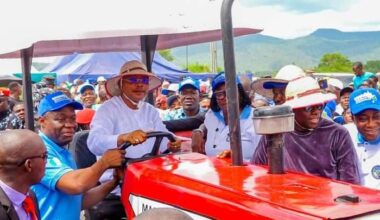The Kogi State Governor, Yahaya Bello has appealed to President Muhammadu Buhari to declare a state of National Disaster in Kogi, as flood has submerged nine local government.
Bello who made the appeal on Saturday during a state broadcast said the declaration will help to unlock the nation’s latent capabilities to respond more aggressively with more men, money and materials to this harrowing situation.
According to him, “the flooding has affected the nine local government areas which lie along the Rivers Niger and Benue, namely, Lokoja, Kogi-Koto, Ajaokuta, Ofu, Igalamela-Odolu, Bassa, Idah, Ibaji and Omala. Ibaji is almost 100% underwater while the rest range from 30% up. Other inland LGAs also have some degree of flooding from smaller rivers and tributaries.
“We, therefore, have a serious and humanitarian tragedy on our hands, but I wish to assure every person, family and community which has been affected that they are not alone and that help is coming. Even before the floods came we had activated our early response systems to make sure that succour reaches those affected in a timely manner.
“Even though we are still mapping the red zones as they develop, the Kogi State Emergency Management Agency (KOGISEMA) and other first responders are already hard at work across the state. At-risk communities were informed and encouraged to evacuate long before the flooding began and Internally Displaced Persons Camps were set up and put at their disposal.
“We are also mobilizing help from traditional partners such as the National Emergency Management Agency, the Federal Ministry of Humanitarian Services, Disaster Management and Social Development as well as socially responsible corporate entities. Of course, the Kogi State Government will welcome public-spirited individuals, groups and bodies who may wish to show love to their fellow humans in distress through donations of funds and essentials.
“What this means is that in the short term we are providing affected persons and communities with shelter at our various Internally Displaced Persons (IDP) Camps, as well as security, food, medicines, clothing and cash grants for necessities, among others. In the long term, we will need to gear efforts towards more sustainable solutions where possible.
He mentioned that the 2022 floods have been confirmed as Nigeria’s worst flood disaster in a decade, and they are becoming progressively worse than those of 2012 and 2018.
He added that in as much as his administration has implemented Flood Early Warning Systems (FEWS) and efforts are ongoing to evacuate and provide relief for victims, they must now admit that more is needed from the Federal Government of Nigeria.
“Historically, flooding in Kogi State is more or less an annual event. Our people have gotten used to the ritual of devastation followed by inadequate palliatives if any. As a leader, it is clear to me that I must make an attempt to break this vicious cycle, if not for all, then for as many victims as I can. This is why I am now considering some proposals that promise permanent solutions that we can deploy.
“Do not misunderstand me. There is a set of common sense and civil engineering solutions to the problem of flooding which could bring permanent solutions and I assure you that as an administration we have tried some of them, with varying degrees of success.
“For instance, in partnership with the Nigeria Erosion and Watershed Management Project (NEWMAP), we have constructed about four kilometres of embankments along the River Niger. We also did extensive gully erosion control projects in Ankpa, Ogugu, Ozuri, Lokoja, Dekina and other parts of the State. Despite all of that, as everyone can see, we continue to harvest this endless cycle of flood disasters every other year.
“The most common sense and humane option left now is to clear human habitations and businesses from the banks of the Rivers Niger and Benue where possible. Soon, we will embark on clearing the lowlands along the entire flood plains in the flood-endemic LGAs. This will allow the rivers’ unimpeded flow during their annual flooding.

